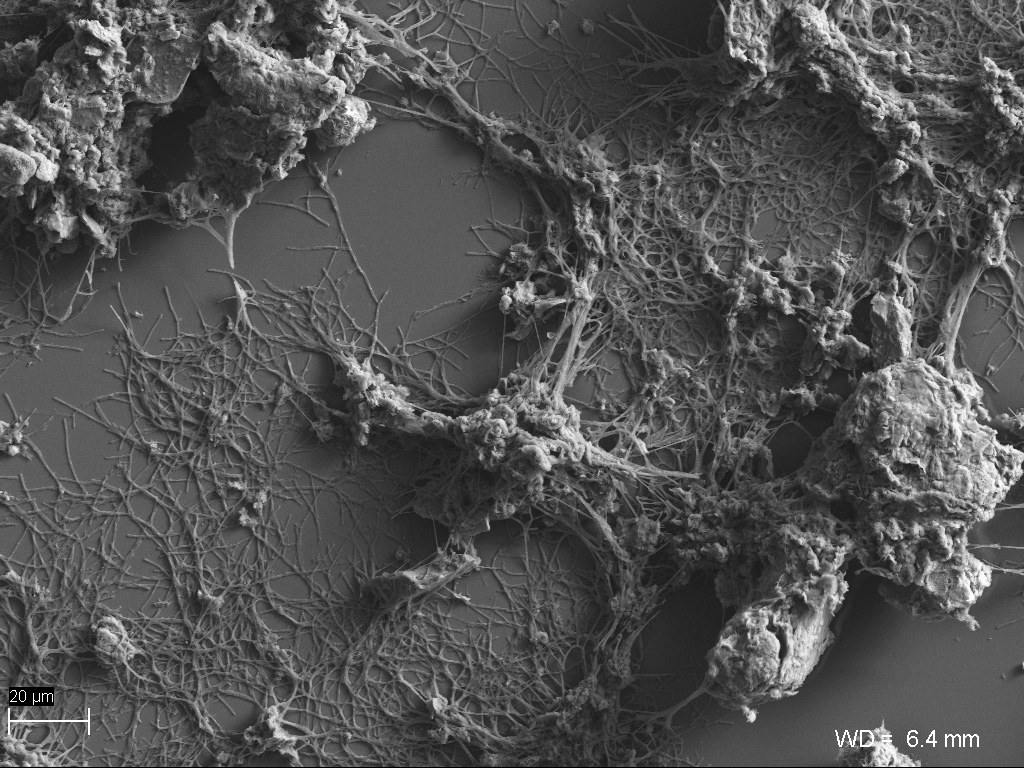Limiting the bacterial population of radiotrophic bacteria
Reducing the adverse effects of excessive radiotrophic bacteria growth in the activated sludge
Radiotrophic bacteria are a group of Gram-positive bacteria commonly referred to as “Nocardia-like Actinomycetes.” This group encompasses many species with similar morphology, such as Nocardia amarae, Nocardia pinensis, Rhodococcus, Gordona, and Skermania. Many bacteria in this group are morphologically indistinguishable, which is why they are often simply classified as radiotrophic bacteria (type Actinobacteria). Their excessive growth is mainly associated with the maintenance of aged sludge in wastewater treatment plants receiving sewage rich in fats and surfactants. However, they can also thrive in environments not only rich in fats but also in sugars, alcohols, acetates, aromatic compounds, or hydrocarbons. The rate of their growth is directly related to the high concentration of substrate.
Recommendations found in the literature for reducing the age of sludge are not always effective. This is due to the accumulation of radiotrophic bacteria in foam or scum. Their high resistance to drying and UV radiation allows radiotrophic bacteria to survive in the floated sludge. Additionally, the presence of fatty substances in the floating sludge fractions promotes their growth. This leads to a situation where the quantity of radiotrophic bacteria in the active sludge is small, while the thickness of the scum continues to increase.
Another recommended approach to reduce the number of radiotrophic bacteria is the application of aluminum ions, which effectively decontaminate radiotrophic bacteria. However, it’s important to note that they only affect the cells present in the active sludge and not those in the scum. This treatment no longer has a significant impact on cells accumulated in the scum. Additionally, in the presence of a high supply of fatty substances, even with prolonged aluminum ion dosing, scum may still appear on the reactor’s surface. Therefore, in the battle against radiotrophic bacteria, frequent actions using various methods (reducing sludge age, using aluminum ions) to limit their population are insufficient.
A new, innovative strategy for controlling radiotrophic bacteria has been developed, directly addressing the root cause of their presence in the active sludge, allowing for:
Reducing the availability of fatty substrates for bacteria → reducing fatty substances using the DuoBent preparation (up to 90%)
Reducing the ability to form foam → demonstrated attachment of radiotrophic bacteria to submicron particles of DuoBent, which directly prevents their transport to air bubbles, thereby reducing foam formation
Improving the sedimentation of sludge rich in filamentous bacteria is significantly aided by the effect of electrostatic interaction, especially in the sedimentation of activated sludge abundant in Actinobacteria
Enhancing clarity and improving the parameters of treated wastewater → reducing suspended solids (up to 99%) and COD (up to 55%)
In doing so, DuoBent attaches radiotrophic bacteria to its particles, also entrapped in the foam, reducing the formation of scum and accelerating their decontamination, for example, with aluminum ions.
Microscopic images of microorganisms in the activated sludge
We invite you to familiarize yourself with the full content of the articles:
Learn more

Limiting the bacterial population of radiotrophic bacteria

Startup and Operation of the DuoFlow Mixer






